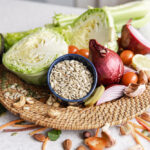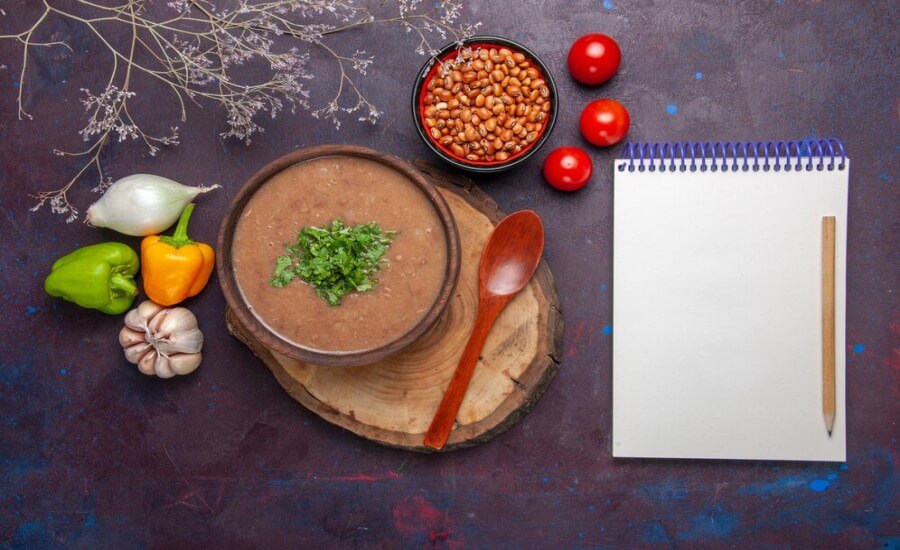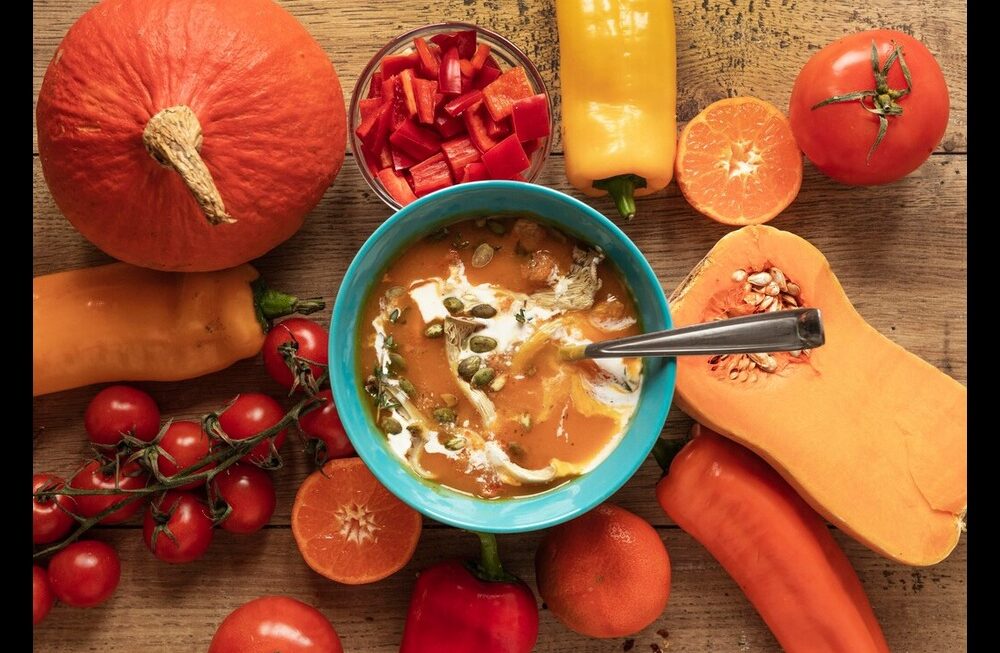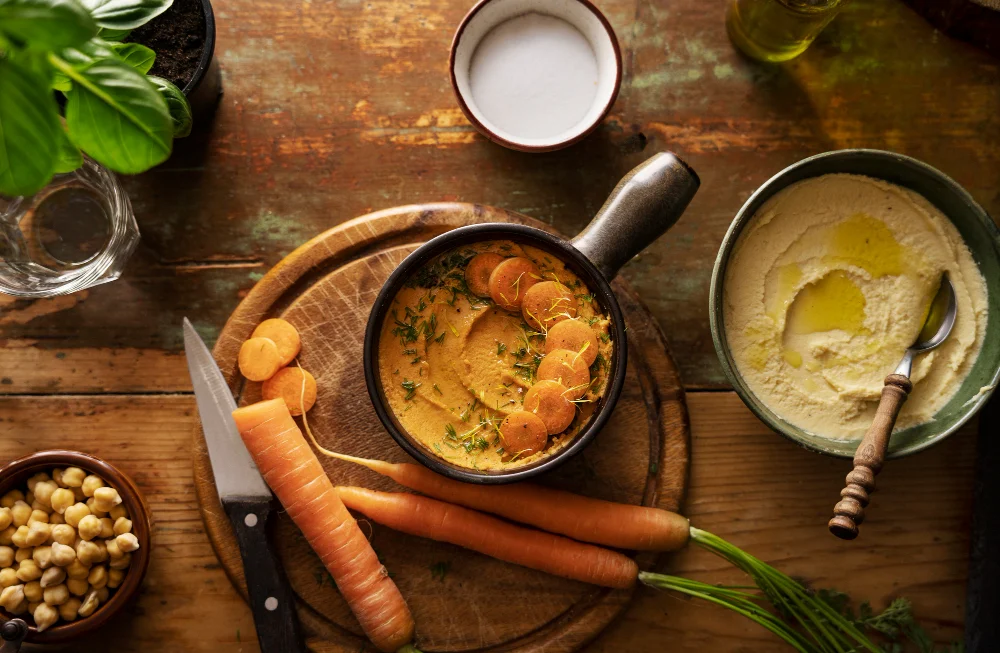When the air turns crisp and the days grow shorter, there’s a universal craving for comfort food – dishes that warm us from the inside out, evoke nostalgia, and offer deep satisfaction. Traditionally, many comfort foods rely on meat and dairy, but the world of comfort food vegan recipes proves that plant-based eating can deliver that same hearty warmth and soulful nourishment. This guide explores delicious vegan comfort food perfect for chilly days (like the winters we experience here in Rajasthan), delving into the nutritional elements that provide warmth, the ethical considerations behind compassionate choices, the environmental wisdom of seasonal ingredients, and practical recipes and tips to bring cozy goodness to your kitchen.
Vegan Comfort Food Recipes for Cozy Winter Days
LENS 1: Nutritional Analysis (Nourishing Comfort)
Vegan comfort food can be both deeply satisfying and incredibly nourishing, especially when designed to combat the chill.
- Warming Spices & Their Benefits: Spices common in Indian kitchens are central to vegan comfort food. Ginger (adrak), garlic (lehsun), turmeric (haldi), cinnamon (dalchini), cloves (laung), black pepper (kali mirch), and chilies (mirch) not only add incredible flavour but are traditionally believed to have warming properties, potentially boosting circulation and metabolism. Many also possess anti-inflammatory and antioxidant benefits.
- Sustained Energy from Complex Carbs: Chilly weather often increases our energy needs. Hearty vegan dishes built on complex carbohydrates like whole grains (bajra, brown rice, whole wheat roti), root vegetables (potatoes/aloo, carrots/gajar, sweet potatoes), and legumes (lentils/dal, beans/rajma, chickpeas/chana) provide slow-releasing energy to keep you fueled and warm.
- Satiety with Plant Protein: Protein contributes to feeling full and satisfied. Lentils, beans, chickpeas, tofu, and peas (matar) are excellent bases for hearty vegan stews, curries (sabzis), and soups that stave off hunger on cold days.
- Richness from Healthy Fats: While traditional comfort foods often rely on ghee or heavy cream, vegan versions achieve richness through healthier plant fats like cashew cream, coconut milk (used judiciously), nuts, seeds, and healthy oils, providing satisfaction and aiding nutrient absorption.
- Balancing Indulgence & Nutrition: Comfort doesn’t have to mean unhealthy. Vegan adaptations often naturally incorporate more vegetables (spinach/palak, cauliflower/gobi, peas/matar common in winter). Techniques like baking instead of deep-frying, using nut/seed creams instead of excessive coconut cream, and loading dishes with fiber-rich ingredients create nourishing yet comforting meals.
- Winter Wellness: During less sunny winter months, ensuring adequate Vitamin D (through fortified foods or supplements) is important for overall health, complementing the comfort derived from warm foods. How can you intentionally incorporate warming spices and diverse vegetables into your next comfort meal?
Nutritional Deep Dive: The Science Behind Warming Spices
Many spices considered “warming” contain compounds that can influence the body’s thermoregulation and circulation. For example, capsaicin in chilies can increase metabolic rate and perceived heat. Gingerol in ginger and piperine in black pepper may enhance thermogenesis (heat production) and improve circulation. While subtle, the cumulative effect of using these spices generously, as is common in Indian cooking, can contribute to a feeling of internal warmth, alongside their significant flavour and antioxidant contributions.
Voice of Experience (Ayurvedic Practitioner): “In Ayurveda, winter is Kapha and Vata season, calling for foods that are warm, nourishing, grounding, and well-spiced. Vegan diets align well, emphasizing cooked vegetables, whole grains like bajra, protein-rich lentils, and spices like ginger, cinnamon, and black pepper to balance the body’s energies and provide internal heat during colder months.” – Vaidya Leela Sharma
LENS 2: Ethical Framework (Compassionate Comfort)

Choosing vegan comfort food infuses the satisfying ritual of eating warming meals with an added layer of ethical consciousness.
- Comfort Without Compromise: Enjoying rich, hearty, satisfying meals without contributing to animal suffering offers a profound sense of alignment. The comfort derived is not just physical warmth but also emotional peace from compassionate choices, avoiding ingredients like meat or dairy/ghee common in traditional comfort dishes.
- Ethical Sourcing: Extend compassion to the human element by choosing fair-trade certified cocoa, sugar, coffee, vanilla, and spices whenever possible. Supporting local farmers by purchasing seasonal grains and vegetables directly connects your meal to the community.
- Sharing Compassion: Preparing and sharing comforting vegan meals during chilly weather, festivals (like Lohri or Makar Sankranti), or family gatherings is a powerful act of hospitality and care. It gently introduces others to the delicious possibilities of plant-based eating and challenges assumptions about what comfort food can be.
- Mindful Preparation & Gratitude: The process of slow-cooking a stew or carefully spicing a dal can become a mindful practice, fostering gratitude for the ingredients and the ability to nourish oneself and others ethically. Reducing food waste by using vegetables fully (e.g., using radish greens/mooli ke patte) is also part of this mindful approach. How does knowing your comforting meal is cruelty-free enhance your enjoyment of it?
Hidden Benefits: Emotional & Ethical Satisfaction
There’s a unique emotional resonance in enjoying food that aligns with deeply held values. The satisfaction derived from a delicious vegan comfort meal is amplified by the knowledge that it was created with kindness towards animals and potentially sourced with consideration for people and the planet.
Voice of Experience (Home Cook & Vegan Advocate): “Veganizing my grandmother’s Dal Makhani recipe felt like honouring her and my own values. Using cashew cream and plant-based butter created that same rich comfort I remembered, but without the cruelty. Sharing it with family during Diwali felt incredibly special – comfort and compassion together.” – Ananya Singh, Marketing Professional
Critical Reassessment: Respecting Tradition While Innovating
When adapting traditional recipes, especially deeply cultural ones, it’s important to approach it with respect. The goal isn’t necessarily to claim the vegan version is the original, but to offer a delicious, compassionate alternative that captures the spirit and comfort of the dish. Engage in dialogue, not judgment.
LENS 3: Ingredient Science & Environment (Sustainable Warmth)

Understanding ingredient properties and their environmental context allows for creating comforting vegan meals that are also sustainable.
- Texture Science: Creating creamy, comforting textures without dairy relies on understanding plant properties:
- Starches: Potatoes, sweet potatoes, pumpkin, or even cooked rice/oats blended into soups add body and creaminess.
- Nut/Seed Creams: Blended soaked cashews or sunflower seeds create rich, neutral creams.
- Legumes: Blended white beans (like cannellini) or even lentils can thicken soups and stews.
- Coconut Milk/Cream: Adds richness and distinct flavour, best used where complementary.
- Environmental Footprint: Plant-based comfort staples shine here. Lentils, beans, chickpeas, potatoes, carrots, and grains have significantly lower carbon footprints and water usage compared to producing meat (beef, lamb, goat) or dairy often found in traditional comfort dishes.
- Seasonal & Local Eating: Emphasizing winter vegetables readily available in Rajasthan (like carrots/gajar, cauliflower/gobi, peas/matar, spinach/palak, radish/mooli, fenugreek/methi, mustard greens/sarson ka saag) reduces food miles, supports local farmers, ensures peak freshness/flavour, and often costs less. Utilizing local millets like bajra (pearl millet) for rotis or khichdi offers a traditional, warming, and drought-resistant grain choice perfect for the region. What local winter vegetables available near you could be the star of your next comfort meal?
Market Transformation Map Suggestion: Data showing increased consumer purchasing of diverse lentils and beans, alongside growth in local organic vegetable box schemes or farmers’ markets, particularly during winter months.
Voice of Experience (Sustainable Food Systems Researcher, India): “Promoting plant-based comfort foods, especially those utilizing local and seasonal ingredients like winter vegetables and drought-resistant millets (bajra, jowar) common in regions like Rajasthan, is crucial for building sustainable and resilient food systems. It drastically reduces environmental pressure compared to meat and dairy-heavy diets while supporting local agriculture.” – Dr. Ramesh Gupta, Agricultural Economist
LENS 4: Everyday Practitioner’s Experience (Recipes & Rituals)

This is where theory meets the kitchen – creating delicious, heartwarming vegan comfort food.
Comfort Food Vegan Recipes (Indian Inspired):
(Adjust spices to your preference)
- Vegan Dal Makhani (Restaurant Style-ish):
- Cook whole black lentils (urad dal) and kidney beans (rajma) until very soft (pressure cooker recommended).
- Sauté onions, ginger, garlic. Add tomatoes, turmeric, red chili powder, coriander powder. Cook well.
- Blend soaked cashews with water to make a smooth cream.
- Combine cooked lentils/beans, tomato masala, cashew cream, water/veg broth, garam masala, kasoori methi. Simmer gently.
- Finish with a tempering (tadka) of cumin seeds and maybe chili in vegan butter or oil.
- Creamy Tomato Soup (Tamatar Shorba):
- Sauté onions, garlic, ginger. Add chopped tomatoes (canned or fresh), vegetable broth, bay leaf, pinch of sugar. Simmer until tomatoes are soft.
- Remove bay leaf. Blend until very smooth (immersion or regular blender). For extra creaminess, blend in a handful of soaked cashews or a small boiled potato.
- Return to pot, season with salt, pepper, maybe a pinch of garam masala. Serve hot with crusty bread or vegan grilled cheese.
- Hearty Mixed Vegetable Sabzi:
- Heat oil, add cumin seeds, asafoetida (hing). Sauté onions, ginger, garlic.
- Add chopped winter vegetables (carrots, potatoes, cauliflower, peas, beans). Stir-fry briefly.
- Add turmeric, coriander powder, red chili powder, salt. Add chopped tomatoes or tomato puree.
- Add a little water, cover, and cook until vegetables are tender. Finish with garam masala and fresh coriander. Serve with roti (especially Bajra roti in winter).
- Vegan Gajar ka Halwa (Carrot Pudding):
- Grate carrots finely. Cook in a pot with plant milk (almond or cashew works well) until milk reduces and carrots are soft.
- Add sugar or jaggery to taste, cardamom powder, and a little vegan butter or coconut oil for richness.
- Cook until mixture thickens, stirring frequently. Garnish with chopped nuts (almonds, pistachios).
- Spiced Masala Chai:
- Boil water with crushed ginger, cardamom pods, cloves, cinnamon stick, black peppercorns.
- Add loose black tea leaves (or tea bags); simmer briefly.
- Add plant milk (oat or soy often work well) and sweetener (sugar/jaggery) to taste. Bring back to a gentle simmer (don’t boil rapidly). Strain and serve hot.
Practical Tips:
- Build Flavour: Don’t skimp on aromatics (ginger, garlic, onion) and spices. Toasting whole spices before grinding enhances flavour. A final tempering (tadka) adds immense depth to Indian dishes.
- Achieve Creaminess: Blend soaked cashews, sunflower seeds, silken tofu, cooked potatoes, or white beans into soups and sauces. Nutritional yeast adds a cheesy, umami flavour.
- Batch Cook & Freeze: Soups, stews, dals, and curries often taste even better the next day and freeze beautifully. Make large batches on weekends for easy weeknight meals.
- Pressure Cooker Power: Utilize pressure cookers (common in Indian homes) to drastically reduce cooking time for dried beans and lentils.
- Create Cozy Rituals: Dim the lights, light a candle, put on calming music – make mealtime an experience, not just fuel. Enjoying warm food in a cozy setting enhances the comfort factor. What’s your favourite way to make a simple vegan meal feel more comforting?
Daily Impact: Winter Comfort Pantry Staples
- Lentils (Masoor, Toor, Urad, Moong), Beans (Rajma, Chana)
- Whole Grains (Brown Rice, Oats, Bajra/Jowar/Ragi flour)
- Root Vegetables (Potatoes, Carrots, Onions, Garlic, Ginger)
- Warming Spices (Turmeric, Cumin, Coriander, Chili, Garam Masala, Cinnamon, Cloves, Cardamom, Black Pepper)
- Canned Tomatoes, Tomato Paste
- Plant Milk (Shelf-stable)
- Nuts & Seeds (Cashews, Almonds, Sunflower/Pumpkin seeds)
- Healthy Fats (Cooking oil, Coconut milk)
- Sweeteners (Jaggery, Sugar)
- Tea Leaves / Chai Masala
Voice of Experience (Rajasthani Home Cook): “In winter here, nothing beats a hot bowl of Dal with Bajra Roti. Making it vegan is easy – just use oil for the tadka instead of ghee. The warmth comes from the bajra and the spices. Simple, filling, and deeply comforting.” – Mrs. Lakshmi Bai, Siyol Resident
Alternative Approaches: Lighter Comfort
Comfort food doesn’t always have to be heavy. Think nourishing vegetable broths, lightly spiced quinoa khichdi, baked sweet potatoes with savory toppings, or warm fruit compotes.
PERSPECTIVE INTERSECTION MATRIX
- Nutrition & Practice (Lens 1 & 4): Nutritional understanding of warming foods and balanced macros (Lens 1) directly informs the choice of ingredients and cooking methods in practical recipes (Lens 4).
- Ethics & Tradition (Lens 2 & 4): The desire for compassionate comfort (Lens 2) motivates practitioners (Lens 4) to adapt traditional recipes using plant-based ingredients (Lens 1, 3).
- Environment & Seasonality (Lens 3 & 4): Focusing on sustainable, seasonal winter produce (Lens 3) shapes the ingredient list for practical comfort food cooking (Lens 4).
- Science & Texture (Lens 3 & 4): Understanding how plant ingredients create creaminess or body (Lens 3) enables practitioners (Lens 4) to replicate comforting textures without dairy.
- Culture & Adaptation (All Lenses): Integrating local ingredients (Lens 3, 4), traditional flavour profiles (Lens 1, 4), and ethical considerations (Lens 2) creates culturally relevant and satisfying vegan comfort food.
MISCONCEPTION ANALYSIS
| Misconception | Reality |
| Vegan comfort food lacks the richness and satisfaction of traditional versions. | Plant-based fats (cashew cream, coconut milk, oils, nuts), umami-rich ingredients (mushrooms, tomatoes, nutritional yeast), slow cooking, and skillful spicing create incredibly rich, deep, and satisfying flavours and textures. |
| Authentic Indian comfort food requires ghee, cream, or paneer. | The soul of Indian flavour lies in spices, aromatics, and cooking techniques. Delicious, authentic-tasting results are achievable using plant-based oils (mustard, sunflower, coconut), nut/seed creams, and tofu/vegetables. |
| Plant-based meals aren’t hearty or filling enough for cold weather. | Meals based on legumes (dal, beans), whole grains (rice, roti), root vegetables, and healthy fats are incredibly hearty, fiber-rich, and provide sustained energy and satiety, perfect for colder days. |
| Making vegan comfort food is complicated and time-consuming. | Many vegan comfort staples like soups, dals, and simple sabzis are quick to make, especially with a pressure cooker. Heartier dishes like stews are perfect for batch cooking and freezing, saving time later. |
| Comfort food, even vegan, is inherently unhealthy. | While often indulgent, vegan comfort food can be made very nourishing by prioritizing whole ingredients, loading up on vegetables and fiber, using healthy fats moderately, and employing healthier cooking methods (baking, stewing). |
KEY TURNING POINTS
- Rise of Global Vegan Cuisine Blogging: Food bloggers sharing accessible, delicious vegan versions of comfort food classics from various cultures (including Indian).
- Improved Vegan Dairy Alternatives: Wider availability and better quality of plant milks, creams, yogurts, and butters making substitutions easier and more effective.
- Focus on Whole Foods Plant-Based (WFPB): Movement emphasizing nutrient-dense comfort food made from unprocessed ingredients.
- Increased Interest in Traditional/Ancestral Eating (Veganized): People seeking comfort in plant-based versions of familiar, culturally significant dishes.
- Restaurant Innovation: Chefs creating sophisticated and satisfying vegan comfort food dishes, proving plant-based potential beyond simple salads.
SYNTHESIS & RECOMMENDATIONS
Vegan comfort food offers a delicious and deeply satisfying way to embrace chilly days while aligning with values of compassion, health, and sustainability. By harnessing the power of warming spices, hearty plant-based ingredients like legumes and root vegetables, and clever techniques to build rich flavours and textures, creating soul-soothing comfort food vegan recipes is well within reach. Whether you’re adapting a beloved family recipe or exploring new plant-based traditions, especially drawing from the rich culinary heritage of India and local Rajasthani produce, comfort can be found in abundance on a vegan plate.
Recommendations:
- Embrace Warming Spices: Generously use ginger, garlic, turmeric, cinnamon, cloves, pepper, and chili for flavour and warmth.
- Build on Hearty Bases: Utilize lentils, beans, chickpeas, root vegetables, and whole grains as the foundation for your meals.
- Master Creamy Textures: Experiment with blended cashews, sunflower seeds, white beans, potatoes, or coconut milk for richness.
- Layer Flavours: Sauté aromatics well, bloom spices in oil (tadka), use umami-rich ingredients (tomatoes, mushrooms), and finish with fresh herbs or garam masala.
- Cook Seasonally & Locally: Take advantage of abundant winter produce like carrots, cauliflower, spinach, peas, and radishes available in regions like Rajasthan. Try local grains like bajra.
- Batch Cook for Convenience: Prepare large pots of soups, stews, or dals and freeze portions for quick, comforting meals later.
- Don’t Forget the Ritual: Create a cozy atmosphere to enhance the comforting experience of your meal.
- Adapt with Confidence: Use these principles to veganize your own favourite traditional comfort food recipes.
FURTHER AREAS OF EXPLORATION
- Vegan Baking for Comfort: Pies, Crumbles, Spiced Breads
- Guide to Making Vegan Versions of Indian Mithai (Sweets)
- One-Pot Vegan Comfort Meals
- Vegan Soups from Around the World
- Using a Pressure Cooker for Fast Vegan Meals
- Incorporating Millets (Bajra, Ragi, Jowar) into Hearty Vegan Dishes
- Vegan Hot Beverages Beyond Masala Chai (Hot Chocolate, Golden Milk)












